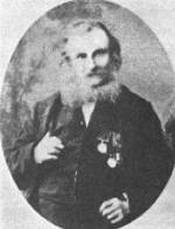Charles Irwin: Difference between revisions
A.N. Other (talk | contribs) (→Today) |
A.N. Other (talk | contribs) No edit summary |
||
| (One intermediate revision by the same user not shown) | |||
| Line 2: | Line 2: | ||
'''Charles Irwin''' (1824-1873) was a Victoria Cross recipient who is buried in [[St Marks, Aghadrumsee]]. | '''Charles Irwin''' (1824-1873) was a Victoria Cross recipient who is buried in [[St Marks, Aghadrumsee]]. | ||
Charles was born in Manorhamilton, County Leitrim, about 15 miles from [[Belcoo]]. Not much is known of his early life but he later became a career soldier. He was not a particularly well disciplined one as his regimental records show that he missed numerous calls | Charles was born in Manorhamilton, County Leitrim, about 15 miles from [[Belcoo]]. Not much is known of his early life but he later became a career soldier. He was not a particularly well disciplined one as his regimental records show that he missed numerous muster calls due to imprisonment. | ||
Charles served in three different regiments: | Charles served in three different regiments: | ||
| Line 9: | Line 9: | ||
* 87th Regiment of Foot – later the Royal Irish Fusiliers. | * 87th Regiment of Foot – later the Royal Irish Fusiliers. | ||
In 1857 Charles was stationed in India during what became know as the Indian Mutiny (or the First Indian War of Independence depending on your point of view). On 16 November 1857 at the Relief of Lucknow he was awarded the Victoria Cross | In 1857 Charles was stationed in India during what became know as the Indian Mutiny (or the First Indian War of Independence depending on your point of view). On 16 November 1857 at the Relief of Lucknow he was awarded the Victoria Cross. His citation reads: | ||
<blockquote> | <blockquote> | ||
For conspicuous bravery at the assault of the Secundra Bagh, at Lucknow, on the 16fh of November, 1857. Although severely wounded through the right shoulder, he was one of the first men of the 53rd Regiment, who entered the buildings under a very severe fire. Elected by the private soldiers of the Regiment. | For conspicuous bravery at the assault of the Secundra Bagh, at Lucknow, on the 16fh of November, 1857. Although severely wounded through the right shoulder, he was one of the first men of the 53rd Regiment, who entered the buildings under a very severe fire. Elected by the private soldiers of the Regiment. | ||
| Line 18: | Line 18: | ||
Charles’ grave is currently unmarked though his final resting place is recorded in David Harvey’s seminal work ''Monuments to Courage''. | Charles’ grave is currently unmarked though his final resting place is recorded in David Harvey’s seminal work ''Monuments to Courage''. | ||
There are still people in the Magheraveely area who bear the ‘Irwin’ surname. Given the fact that the family was living | There are still people in the [[Magheraveely]] area who bear the ‘Irwin’ surname. Given the fact that the family was living there in the 19th century and the small size of its Anglican community then it is highly likely that they share some common ancestry with the V.C. recipient. | ||
[[Category:People]] | [[Category:People]] | ||
Latest revision as of 09:12, 30 January 2010

Charles Irwin (1824-1873) was a Victoria Cross recipient who is buried in St Marks, Aghadrumsee.
Charles was born in Manorhamilton, County Leitrim, about 15 miles from Belcoo. Not much is known of his early life but he later became a career soldier. He was not a particularly well disciplined one as his regimental records show that he missed numerous muster calls due to imprisonment.
Charles served in three different regiments:
- 18th Regiment of Foot – later the Royal Irish Regiment;
- 53rd Regiment of Foot – later the King’s Shropshire Light Infantry;
- 87th Regiment of Foot – later the Royal Irish Fusiliers.
In 1857 Charles was stationed in India during what became know as the Indian Mutiny (or the First Indian War of Independence depending on your point of view). On 16 November 1857 at the Relief of Lucknow he was awarded the Victoria Cross. His citation reads:
For conspicuous bravery at the assault of the Secundra Bagh, at Lucknow, on the 16fh of November, 1857. Although severely wounded through the right shoulder, he was one of the first men of the 53rd Regiment, who entered the buildings under a very severe fire. Elected by the private soldiers of the Regiment.
Today
Charles’ grave is currently unmarked though his final resting place is recorded in David Harvey’s seminal work Monuments to Courage.
There are still people in the Magheraveely area who bear the ‘Irwin’ surname. Given the fact that the family was living there in the 19th century and the small size of its Anglican community then it is highly likely that they share some common ancestry with the V.C. recipient.